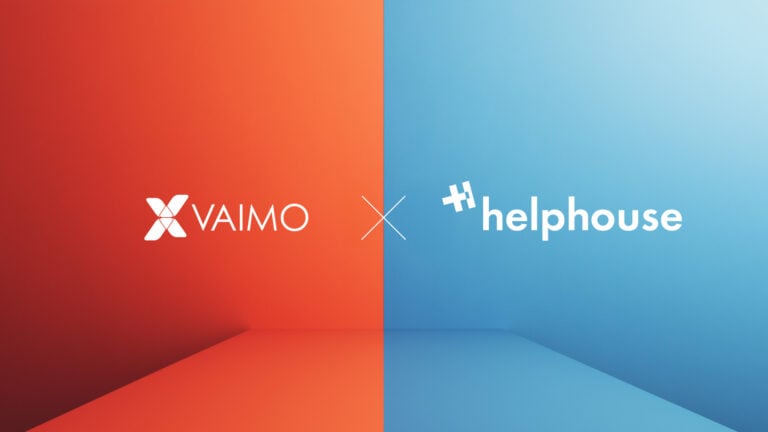When the first COVID-19 cases were reported in December 2019, nobody was expecting the profound effect it would have on all of us, even more than a year later. With offices in 14 countries and clients across North America, EMEA, and Europe, we published an eCommerce business guide to analyze the tectonic shifts COVID-19 is causing.
A Practical Ecommerce Business Guide
At Vaimo, we see how the COVID-19 pandemic affects eCommerce. We help global brands like Champion and Helly Hanson to match unique brands with eCommerce. We’ve even assisted Jaguar to bring their luxury vehicles online. Our expert perspective on eCommerce inspired us to create a COVID-19 eCommerce guide to help you sell online in the months and years to come.
In our guide, you get a free resource on topics such as COVID-19’s impact on eCommerce, Customer Experience and Cybercrime. We will also share case studies from Elon and Champion, who successfully launched their eCommerce sites during the COVID-19 pandemic.
The Table of Contents:
Click to Start Reading & Bookmark for Future Updates:
- Introduction
- 2021 CEO Ecommerce Trends
- How Does COVID-19 Impact Ecommerce?
- How Does COVID-19 Impact Customer Experience?
- How Is Cybercrime Connected to the COVID-19 Pandemic?
- COVID-19 Business Case Studies
INTRODUCTION
The COVID-19 pandemic has affected all of us. We certainly noticed the difference at Vaimo. As a full-service omnichannel agency on the Adobe Experience Cloud platform, we deliver strategy, design, development, and managed services to brands, retailers, and manufacturers all over the world. Across our offices in 14 countries, the COVID-19 pandemic hit each one differently. Some of our offices were affected less, but most have had to operate under strict restrictions.
On August 11th 2020, The Economist noted that it took 6 months to reach 10M global COVID-19 cases and just 43 more days for that total to double to 20M. With the registered cases now at over 100M globally, consumers will continue seeking products online.
Discussing the effect of COVID-19 on eCommerce remains difficult as certain statistics appear contradictory. But the signs of eCommerce growth are undeniable. Even before the crisis, the annual European Ecommerce Report showed a 14.22% growth in European eCommerce in 2019. Without a doubt, eCommerce is growing, and it appears that the COVID-19 pandemic is further intensifying eCommerce. In many places, storefronts are still relying almost solely on online interactions.
The changing nature of commerce has forced shoppers to buy whatever brands are available which, more often than not, leads them online. Vox Media noted that 88% of consumers tried at least one new brand during the pandemic. With many companies lagging in eCommerce, consumers opened their pocketbooks to firms big and small.
The new consumer behavior exposed early winners and losers. During the pandemic, companies more heavily focused on eCommerce and direct-to-consumer sales have seen impressive results, according to DigitalCommerce360. In particular, brands that aggressively engaged in online marketing saw their sales grow 70% compared to a 42% decrease with brands that curtailed their marketing efforts.
The potential for unbelievable profits sent Nike Inc. on a new path. Despite a poor first-quarter, Nike reported a 75% increase in digital sales. The results drove Nike’s management to change leadership and invest deeper into a direct-to-consumer strategy. Nike Inc. announced that it would reorganize management to grow D2C, navigate its partnerships, and create long-term profitability. Yes, digital sales increased, comprising 30% of revenue with a goal of 50% of Nike’s sales in the future. The change accompanies Nike’s ambitious measure to open 150 to 200 new, smaller footprint stores in North America, which give customers a more intimate shopping experience along with their mobile presence.
The longer the crisis lasts, the more eCommerce will overshadow traditional sales channels. Though leaders watched their forecasts change soon after 2020 began, the unexpected shift yields new possibilities. The trends for 2021 promise a continued focus on eCommerce.
In this guide, we offer our take on how the pandemic affects eCommerce, customer experience, and cybercrime. We will also share case studies from Elon and Champion, who successfully launched their eCommerce sites during the COVID-19 pandemic.
2021 CEO ECOMMERCE TRENDS

DAVID HOLENDER
Vaimo Co-founder & CEO
The COVID-19 pandemic has left an unforgettable mark on our lives and the global economy. Though many industries stalled, eCommerce soared, with our 2020 predictions only increasing in importance. As we look at 2021 eCommerce trends, the need for a digital-first approach is essential, as businesses must guarantee personalized and secure digital experiences.
THE COVID-19 PANDEMIC & ECOMMERCE IN THE NEW NORMAL
The COVID-19 pandemic accelerated an already growing eCommerce industry. The late adopters, the baby boomer generation, were pushed online, where 45% are shopping online more often than before the crisis. This shift accompanied a broader trend of online sales, as DigitalCommerce360 notes, where the growth of online sales grew by 40%. Ecommerce is not only here to stay in 2021 — it’s thriving.
Another offshoot of COVID-19 is the increasing comfort with virtual meetups. We spend a large part of our daily lives on Zoom, Google Meets, Microsoft Teams and so on. This new behavior raises the question: why do we need to meet in-person? This question taps into the need for unified commerce where each business will need to meet their customer online as the first touchpoint and use eCommerce to integrate their sales channels. As a result, COVID-19 makes in-person meetings secondary.
DIGITAL FIRST IS NO LONGER AN AFTERTHOUGHT
In 2021, companies will need to be digital-first. 35% of U.S. consumers said they would be happy if they never made an in-store retail purchase again. For example, Nike is betting that this behavior continues and projects 50% of its sales to come from eCommerce by 2025. With global brands changing their organizations and in-store presence to support eCommerce, it’s also your time to move in a new direction.
This new direction is known as experience-driven commerce, where you assist customers from start to finish regardless of the sales channel. And physical no longer drives the experience: 63% of baby boomers, the most faithful in-store shoppers, say that curbside and in-store pickup improved their overall shopping experience. Given the fundamental changes in consumer behavior, you need to meet shoppers online.
CUSTOMER DATA & CUSTOMER DATA PLATFORMS
With the majority of shoppers moving online in 2020, customer data management is essential. It’s critical to know where customer data is, how it’s used, and how to manage it. After all, you’ll struggle to personalize your digital experience without using customer data. Many businesses are handling this issue by adopting customer data platforms (CDPs), which gather user data from different systems to create a full picture of your customer.
When done right, CDPs help your entire organization, such as marketing, sales and operations. But, it’s not imperfect: 87% of marketers are using or implementing a CDP, but 23% believe they lack the customer data to leverage their martech (marketing technology) products, according to Gartner. Even with barriers to application, the mass exodus of customers from notable brands means that businesses must assess and manage their customer data more critically to win new shoppers in 2021.
BACK TO THE SUITE LIFE
Companies are once again choosing suites over point solutions. While point solutions offer the best option to solve a specific problem, they require resources and patience to integrate them into your business. With resources and patience in short supply during the COVID-19 pandemic, all-in-one suites — an integrated system of tools from a single vendor — are taking over.
The preference for suites over point solutions is evident in the area of martech. For example, 59% of marketers preferred marketing suites compared to 36% who chose the best-of-breed solution. This conclusion benefits the more prominent industry players, such as Adobe and Salesforce, which are better known and offer a comprehensive martech stack. As cost pressures and economic turmoil force martech optimization and innovation, the decision to choose industry leaders will change the martech industry and also alter similar domains, such as commerce stacks, in 2021.
DIGITAL THREATS
Cybersecurity is closely related to customer data, as innumerable threats pose a significant risk to businesses’ reputations in 2021. According to Cybercrime Ventures, global cybercrime is growing 15% annually and will cost the global economy 10.5 trillion USD per year by 2025. Economic turmoil and the COVID-19 pandemic only heighten this threat. Major events, such as natural disasters, make businesses more vulnerable by using the general public’s confusion and lack of attention to their benefit.
Business leaders need to take measures to defend against cybercrime. First, they must adhere to local legislation, which gets more challenging every year. Second, they need to take steps to ensure their customers’ trust. The younger generations are concerned about inappropriate use of their data, and older generations are worried about using online services to fulfill simple transactions. One misstep in security can nullify years of success. 69% of individuals would avoid a company that has had a data breach, even if it offered a better deal than its competitors, according to a Verizon survey. With a myriad of threats to eCommerce, a primary focus for 2021 is defending your site from cyber threats.
Thank you for reading my take on the key 2021 eCommerce trends. For all of us, 2020 came with a great deal of hardship. With vaccines on the horizon, I hope that you share the optimism that 2021 offers to your loved ones, as well as your business potential.
We’re looking forward to helping you navigate the new normal and grow your digital capabilities in the shifting eCommerce landscape.
If you’d like to discuss your 2021 strategy and eCommerce requirements, then don’t hesitate to reach out to our team. Here’s to a great year ahead!
HOW DOES COVID-19 IMPACT ECOMMERCE?

HENRIK FELD-JAKOBSEN
Vaimo’s Head of Strategy and Consulting
Working in eCommerce since 2008, it’s always been natural for me to perform research and educate myself online before bigger personal purchase decisions. But in most cases, I still ended up in a physical store to touch and feel the product. Or so that I could instantly make a purchase when I made the final decision.
Going through these current times, however, I shifted my purchase behavior online—and both the numbers and the fact that delivery networks are under pressure, tell the story that many people are doing the same thing.
For me, this has happened quite naturally without further consideration.
I’m in my early thirties, consider myself healthy and have recently moved with my family from Denmark to Sweden. This situation hasn’t naturally provided me opportunities to make many new contacts, besides a closed group of friends, colleagues and family. And since I’ve no commute (I’m currently working from home) and don’t have the same daily movement as usual, ordering online has simply been more convenient.
I’ve also caught myself ordering online from new product categories, such as groceries, meals and generic household items—things I’d usually pick up from the mall or supermarket.
Whether my behavior is unique is hard to tell. Many of us have been ‘pushed’ to order our groceries online since the COVID-19 outbreak, since we want to avoid going to stores. But habits are easy to form and we might find that we create new habits as a result of COVID-19 given that we prefer the convenience of shopping online. And the general numbers do show that eCommerce is on the rise with more people shopping from the comfort of their homes.
ONLINE SALES ACCELERATED IN MID-MARCH
Digging into online publications and our clients’ statistics, it confirms the same growth trend starting in the middle of March. Across most industries, sales started to slowly increase week by week. And what’s more interesting is that the numbers are starting to stabilize despite some countries slowly opening up again.
Most industries (except for travel retail and tourism services) are seeing the eCommerce transaction rates stabilize to the same level they reached in April 2020, after a peak during the Christmas shopping season.
Data snapshot February 9th from Contentsquare – Contentsquare has analyzed more than 7 billion sessions across 20+ industries and 26 countries.
PEAK IN DELIVERIES
Though the unprecedented 2020 eCommerce sales won’t repeat again, more sales will continue to take place online because of its convenience. But how can merchants respond to this change? After all, they need to rely on companies like DHL, FedEx, and Amazon to put the packages on the front step and ring the doorbell. COVID-19 caused this fulfillment issue, but it will likely continue to plague businesses during important holidays.
Luckily, two alternative digital options are making fulfillment easier and less expensive: click-and-collect and buy-online-pick-up-in-store (BOPIS), which assist in getting customers what they need on time. And I’m hearing about other similar trends happening across all the countries we are operating in as pressure on logistics systems mounts due to increased online sales.
HOW COVID-19 IS PUSHING DIGITAL TRANSFORMATION
We’ve seen companies freezing investments due to uncertainties or supply chain impacts. And others have been forced to close their primary sales channels due to local lockdown restrictions.
On the other hand, I also engage with companies that, due to COVID-19, have put eCommerce and digitalization at the core of their strategy, with a strong push from the board and shareholders. Others are ramping up investment and want to move faster to monetize on the trend and get ahead of competitors.
I’ve come across many business leaders who had digitalization on their radar, but always put the core business model first—and digital was an outlier in their strategy. That has changed for many during COVID-19 as they see the impact on society, business, and personal lives.
As someone working with digital enablement and transformation, helping companies to onboard and grow eCommerce, I have a very positive outlook on how this will make the change management and organizational anchoring of digital easier.
THE OUTLOOK FOR ECOMMERCE POST COVID-19
Ecommerce will most certainly not keep its current growth rates as the world is preparing to ease the lockdown measures, but the baseline will be higher. In light of the improvements and services implemented during COVID-19, such as more flexible delivery options, online assistance and better availability, eCommerce has taken a big leap forward over the last year.
The duration of the lockdown and the expected restrictions during the next few months also mean that we are settling into new routines—and some things will just become the new normal. Will I continue to buy groceries and meals online? I personally don’t see why not.
Though eCommerce is already seeing double-digit growth rates in most European countries, I’m sure in 2021 we’ll see some further unexpected growth numbers which might not have taken place without the pushes in our own behavioral changes.
So if you’re currently not online—and not available for your clients and customers as a result—now is the time to make it happen.
As Sandy Shen, Director of Research at Gartner puts it:
“This is a wake-up call for organizations that have placed too much focus on daily operational needs at the expense of investing in digital business and long-term resilience. Businesses that can shift technology capacity and investments to digital platforms will mitigate the impact of the outbreak and keep their companies running smoothly now, and over the long term.”
If you want to fast track your eCommerce onboarding and digital transformation, reach out to us and learn more about how our Quick Launch Accelerator and best practices help retailers, brands and manufacturers to launch at speed and with success from the start.
HOW DOES COVID-19 IMPACT CUSTOMER EXPERIENCE?
Crises breed change—both at a societal level but also within us all, personally. As COVID-19 has taken hold, we’ve all had to alter our habits and have likely seen changes in our behaviors, attitudes, beliefs and motivations. And it’s this collective change in mindset that businesses must consider in adapting to the needs of the COVID-19 customer. Whether you previously prioritized customer experience or not, now is the time to reevaluate this term and what it means for your business. The reason? It’s changed. Yes, there are universal customer experience principles that still exist. But we must consider the evolving mindset of COVID-19 customers. What binds them is a set of anxieties, fears and sensitives that have arisen as a result of the pandemic.
In this article, we’ll be exploring some of the ways customer behaviors are changing in the wake of COVID-19 and how your business can respond.
PROBLEMS OF THEIR OWN
COVID-19 is impacting a variety of people in very different ways. From health concerns and economic pressures to job security and cancelled plans. Whatever shape these troubles may take, the point is that a higher proportion of shoppers are dealing with the stress of these issues when arriving at your online store (maybe for the first time). So just like talking to a good friend in a time of crisis, your eCommerce store needs to support above everything else.
This will manifest itself differently depending on your store and industry but key areas to consider are:
- Increasing on-site messaging e.g around delivery times or physical store opening times.
- Making customer service contact obvious, accessible and easy.
- Proactively providing added flexibility so that customers can amend, cancel or postpone orders without the added worry of, “What if they won’t let me?”
- Talking like a human—in times of need your customers want to be heard and appreciated. Now’s not the time for authoritative business lingo and flashy marketing campaigns. Customers want a caring and honest helping hand.
MORE CLARITY, LESS AMBIGUITY
If there’s one thing customers have had enough of, it’s uncertainty. There’s already enough uncertainty in our personal and professional lives without having to think about the state of the world’s problems in general. Throw in fake news, misinformation and rumors and you’ve got yourself a breeding ground for fear.
To counter this, your eCommerce store needs to provide clarity, predictability and reassurance. It might be clarity in how you communicate your store updates or changes to delivery options. Or you may want to address this by rethinking your key user journeys and making site navigation as simple as possible. Weed out any potential areas that may be jarring for your customers. Anticipate their needs and provide an eCommerce experience that’s intuitive and easy to follow from your homepage through to checking out.
Get a free tailored customer experience report today! Our CXR report scores across 12 areas of CX excellence so that you can get clarity on how to improve your CX and drive greater conversions.
REPLICATE THE PHYSICAL, DIGITALLY
Whether by choice or by force, less of us are visiting brick and mortar stores. Instead, we’re opting to shop online. And for many customers, it may be the first time they’re ordering a certain product category without ever having seen the product in the flesh.
To gain trust and credibility, you need to give customers what they were getting in-store, on their laptop or mobile screens.
But how?
Think about how you can turn your product knowledge into tangible assets on your site and in your social media. There’s plenty of opportunity for video content here around how-to guides, hands-on assembly instructions, product walkthroughs and demos. Or how about content-led initiatives like inspirational look books, shopping guides and user testimonials? Several Vaimo clients have also benefited from product configurators so that customers can visualize how the end product will look. Whichever form it takes, the goal is to make your eCommerce store more interactive so that customers get a little slice of that in-store feeling when a rep comes up and asks, “how can I help you today?”
See how we implemented leading eCommerce integrations to transform DOMU Brands’ customer experience initiative!
IT ALL STARTS WITH TRUST
Trust forms the core of your customer experience initiative. Without it, there’s no relationship, no conversion, no repeat visitor and no brand advocate. We’ve already discussed the external environment in which shoppers are arriving at your store. Trust, therefore, is more important than it’s ever been—particularly for those less digitally-savvy shoppers who may be buying online for the first time.
This is where you can leverage eCommerce features to make sure that every step of the customer journey instils trust.
- We touched on it in the above point, but reviews and user-generated content are a surefire way to develop trust. Without being able to visit a store, customers are relying on others’ experiences before purchasing. And the more reviews (and different types of reviews) the better.
- Personalized emails and on-site messaging that take into account a customer’s preferences will help develop the bond between you and your customer. One size fits all blanket emails just won’t cut it here. Customers want to know (particularly during a pandemic) that they matter and that they’re being heard. Here’s your chance to let them know you’re on their side and are there for them.
- A bad checkout experience is enough to break any trust. We’ve all probably had a time where we input our credit card details, pressed pay and then got an error screen and no confirmation of purchase. Did it go through? Do I have to do the whole process again? Has someone tried to steal my credit card details? At Vaimo, we can integrate a payment gateway from one of our trusted partners to provide your customers with the smooth and safe checkout process they demand.
The spread of coronavirus has brought uncertainty, panic, and fear to people around the world. It has also frozen the operations of some organizations due to governmental regulations, changing consumer behavior, panic, or all of the above.
Daily, we get news, regulations and actions required; all due to coronavirus. Simultaneously, we all have to run our businesses and put in more effort than before, to make sure that we survive and come out of the crisis ready to help our clients. And while all this is happening, in the background coronavirus has given rise to the spread of online viruses, malware, scams, and fraud.
HOW IS CYBERCRIME CONNECTED TO THE COVID-19 PANDEMIC?
Even though it may be surprising that the global virus has triggered a surge in cybercrime, there is nothing new in such tactics used by hackers. Other major events, such as elections, the Olympics and natural catastrophes have also triggered similar actions. Hackers use the general public’s confusion, lack of attention and over exasperated attention for their gains. People are distracted by major news or events, and it is easy to use this distraction.
However, the distraction has never been at its current scale. It’s not only individuals but also companies and governments; the whole world is focused on the virus and distracted from many other activities. Even more, for the first time in history, people are working from home offices at a large scale and have shifted their daily activities, such as shopping, entertainment, and sports online.
Since our daily routines have changed, we know that many businesses also need to change due to the current lockdown. We expect things to be different and may not notice that the difference is suspicious. However, we may be interacting with many services for the first time, and have no idea about their regular flows, processes, etc.
Then, some businesses have experienced unexpected surges in demand, and might not have been prepared to handle this demand from an operations standpoint nor from a security perspective. Plus, many businesses weren’t prepared to handle a fully-remote workforce for an extended period.
As a result:
- employees may be accessing sensitive information from unsecured networks or devices
- employees might be granted access to information they should have never had access to
- security processes might not be followed fully or not at all from the home office environment
So, due to these distractions and changes, companies may find themselves in a vulnerable situation from a cybersecurity perspective.
HOW DO DATA BREACHES HAPPEN?
According to a CybSafe report compiled from data from the UK’s Information Commissioner’s Office, 90% of data breaches happen due to human error. This may include sharing usernames and passwords, writing passwords in unprotected tools or places, using easy to compromise usernames and passwords, opening suspicious emails, clicking on strange links, and not being cautious. Usually, human error is caused by a shortage of time, poor security training, poor processes, distractions and good intentions. We are all familiar with situations where someone shared usernames and passwords to access tools and systems to save time, money and to be more efficient.
The distraction around COVID-19, home offices and human mistakes make a great combination for hackers to capitalize on. Cybersecurity firms are reporting that hackers are also using COVID-19 as a hook for victims. Through email campaigns, they can deliver spam, steal credentials, infect a computer with malware and trick people into paying outstanding bills to their bank account (instead of the merchant’s). They also impersonate trusted organizations that require victims to take urgent action.
Some attacks are directly linked to COVID-19, and some just use the distraction to go through with their standard set of actions but at increased levels. For instance, at the end of March, another Magecart attack was reported. This time it was NutriBullet. What is interesting about the NutriBullet attack is that it has been performed by a group of groups, which is quite unusual. The malware was removed from the website repetitively, but it is believed that the hackers still have access to the infrastructure. The company is working with outside cybersecurity specialists to secure the site and work through the aftereffects of the attack.
A CLOSER LOOK AT MAGECART ATTACKS
The number of criminal groups conducting Magecart attacks is growing. These groups have different motivations and targets but use the same tactics and techniques with the goal of financial gain. Usually, the main goal of Magecart attacks is to steal personal data, including credit card data and sell this data on the black market. Additionally, the stolen credentials may be used for other more sophisticated attacks to commit fraud on other websites.
Magecart or front-end types of attacks usually use JavaScript vulnerabilities and use the client-side browser as a front-door to a client’s data. As a first step, hackers gain access to a website. They do it by either breaking into the infrastructure and placing a skimming malware there or by exploiting vulnerabilities of third-party tools. Generally, websites are complex systems that use third-party code and tools to be more efficient, convenient, and customer friendly. This is beneficial as sites have good tools, are cheaper and faster to develop. However, the owner of the website is not in control of the entire code of this website since third-party code has the same level of privilege as proprietary code. A website may have code from 30 different parties having the same privileges as the owner’s code.
That’s why it’s easy to hack into numerous websites once a third-party vulnerability is discovered. So, when the malware is injected into the website, it collects sensitive information entered by consumers on the website. This collected information is then sent to a location controlled by hackers.
MAGECART OR FRONT-END ATTACKS CAN BE DISASTROUS IN SEVERAL WAYS.
Firstly, they are almost impossible to detect. Secondly, since they are hard to detect, they last for months until detected, which means that a large number of website users may be affected. Thirdly, when the malware is removed from the website, it’s often not secured properly, which means that the malware can get in again in the same way as in the first place (as was the case for NutriBullet and Marriott). Lastly, reputational damage and legal ramifications can be devastating to a company.
Today, when people not only want to but have to or are encouraged to do their daily errands, such as shopping, sports, etc. online due to the pandemic, the playground has shifted significantly for many companies. While some are suffering from significant losses, others see an unexpected surge in traffic and transactions. Those websites with high traffic may quickly become a “sweet-spot” for hackers if huge traffic is coupled with the improper security setup.
The heady combination of brand new users, distracted existing customers and a busy business provide the ideal conditions for hackers to access sites, insert malware and cause considerable damage.
It’s also good to keep in mind that company size doesn’t matter for hackers. Anyone can find themselves under attack and smaller companies are often preferred since they are deemed to invest less in cybersecurity.
HOW CAN YOU MINIMIzE THE SPREAD OF MALWARE AND AVOID DATA BREACHES?
- Companies need to make sure that cybersecurity is top of mind. This can be the last thing to prioritize during a crisis, but ensure that access to your infrastructure, security practices and processes have not been compromised due to changes in your operations.
- Understanding trends and risks are key. Having a clear picture of vulnerabilities that may influence your business will help you deal with potential threats. These are some of the most common risks: hacking, phishing, malware, identity theft and keylogging. Are your people well aware of those risks and do they know what to do? And more importantly, do they know what not to do, or is it only your IT department that understands the threats? Make sure to educate your employees. It’s critical that everyone understands basic cybersecurity principles and is on the lookout for suspicious activity and follows the security policies and procedures you have in place.
- Put security policies in place and ensure they’re adapted to the current working environment. In addition to policies, a response plan needs to also be reviewed, potentially modified, or created.
- Make sure your software, tools, and hardware are up-to-date and patched. If your employees use their own devices, make sure that those are also safe, and that security policies and processes are followed.
Lastly, make sure you have adequate tools to protect your website and alert you if a breach occurs so that it doesn’t go unnoticed for a prolonged period, leading to devastating consequences for your business.
DATA BREACH MONITORING
Data breaches occur every day and are growing in both volume and scope as cybercriminals devise new methods to target and expose sensitive data. A 2020 Mid Year Data Breach QuickView Report by Risk Based Security revealed that over 27 billion records were exposed between January 1, 2020, and June 30, 2020, surpassing the total number of records exposed during the whole of 2019 by over 12 billion records. Experts predict that the number and type of data breaches in 2020 far exceeds the figures from 2019.
In response to this global threat to all businesses, we’ve developed a tool that detects all major breaches (Magecart attacks, supply-chain attacks, skimming and form-jacking) in real-time. We do this by running scripted user journeys on your site comparing outgoing server addresses to whitelisted addresses and acting on any new, suspicious calls. With this immediate alert mechanism, we’re able to take appropriate action before a breach can wreak havoc on your business. Vaimo’s Data Breach Monitoring tool reduces detection time—and the potential impact on your business—from days, weeks or months to just minutes.
In today’s eCommerce environment, it’s this quick action that’s crucial to your business’ success and your customers’ safety. Because without adequate monitoring and protection, the impact of a data breach on your business could be irreversible. There are many ways your company will stand to lose due to a data breach.
- Financial loss incurred from tackling the breach itself
- Operational disruption as things grind to a halt
- Potential legal and regulatory consequences
- Reputational damage of having data exposed
It’s through the introduction of this tool that we want to fight back against the growing influence of data breaches and help your business to mitigate risks so that you can carry on operating as usual. We also appreciate that due to the ongoing global crisis, you may be facing a number of different challenges all at once. And this is why we’ve designed the tool with simplicity in mind. You don’t need to waste time on webserver access rights or handing over your site code. To get this tool up and running, all you need to provide is a website URL and your user journeys—we’ll then get everything set up, and your business defended from cyber attacks. Plus it doesn’t matter what type of eCommerce store you have—our tool can be used on any website, no matter what eCommerce platform you’re running on.
If you’re interested in learning more about the tool and discussing your options, then simply book a call with our dedicated Data Breach Monitoring team today. We can talk through your specific business circumstances and requirements and find a solution to match your needs.
COVID-19 BUSINESS CASE STUDIES
ELON SUCCESS STORY
Elon is the Nordic region’s largest retail chain for consumer electronics and home appliances, with over 400 stores in Sweden alone. As part of their plans to rebrand, Elon integrated to Magento Commerce Cloud, to meet their new brand concept of a modern in-person and online user experience.
As Elon unveiled its new brand and eCommerce site, COVID-19 began to radically transform consumer behavior. Since physical locations saw a decrease in shoppers during the pandemic, the eCommerce experience became the front line for Elon’s interaction with potential customers. Additionally, older customers have turned to Elon’s online store for both research and purchases. Customers also use the eCommerce site to book the best times to pick up their products at a physical store. As a result, the improved online functionality allows Elon’s eCommerce store to support physical stores which saw a decrease in foot traffic and sales during the pandemic.
Elon’s strategy aligns with the idea that online customer activity leads to greater in-person activity. When collecting products purchased online, for example, customers have purchased additional products in physical stores. Thanks to Elon’s omnichannel approach, they unify the customer’s online user experience with the excellent customer experience found at any of its storefronts.
Elon’s omnichannel solutions drive high client engagement and complement their 400 stores with an intuitive shopping experience. When the customer shifts between the in-person store and the eCommerce store, they receive the same high-quality experience that the Elon brand guarantees. As Elon focuses on their services, installation and aftermarket care, Magento Commerce helps Elon serve customers regardless of time or place. The eCommerce solution gives a personal feel, extending the comfortable atmosphere available in all physical stores into the digital space. As part of the in-store rebranding, the concept of dividing the stores into rooms has also been implemented into the online store, helping the digital to reflect the physical.
ELON’S SUCCESS IN NUMBERS:
- 50% sales growth in 2020 compared to 2019
- Ecommerce sales (including reservations) increased by 100% in 2020 compared to 2019
- June 2020 sales exceeded Black Friday sales in 2019
To find out more about Elon’s success launching their new Magento Commerce platform during COVID-19, click here.
AN INTERVIEW WITH CHAMPION EUROPE GROUP
At the start of June 2020, we launched a new Magento eCommerce site for our client Champion Europe Group. To celebrate the launch, we caught up with Nicholas Freddi (Senior Manager Sales and Marketing E-Commerce, Champion Europe Group) to hear about the new site and much, much more. Let’s listen to what Nicholas had to say about the eCommerce store and future of the Champion brand.

NICHOLAS FREDDI
Senior Manager Sales and Marketing E-Commerce, Champion Europe Group
Hi Nicholas and congratulations on the Champion site launch! Before we get into the site itself, let’s rewind the clock to when the idea of a new eCommerce store first surfaced. What did you want to achieve, and what were you looking for in a solution partner?
Before working with Vaimo, we were operating on a legacy system that was giving us a number of headaches. It was no longer fit for purpose, and we knew that we needed to change to stay ahead in a competitive eCommerce environment. From the start, we decided on the Magento Commerce platform—a flexible solution that could be tailored to our needs and that we could scale with in the future.
Of course, it all sounds easy in theory, but in reality, this eCommerce project was looking complex and multifaceted. We understood the challenges ahead and needed a partner with a number of qualities. Expertise was top of the list, especially given the complexity of our legacy system. But we also needed a partner who had experience with migrations and who we could trust to take us from point A to B without any disruption. These points are what led us to Vaimo given the team’s experience in delivering proven eCommerce results across markets and industries. And then through Vaimo, we were able to identify leading tech partners to help us deliver the best eCommerce site possible.
In today’s competitive landscape, customer experience is everything. Can you tell us how your new site meets the expectations of the modern-day customer?
For me, customer experience is a journey that never ends. The online and eCommerce worlds represent such a competitive space given the low barriers to entry. As such, businesses cannot afford to stand still.
Although the new site is live, we’re still building and optimizing the CX all the time. We want an experience that speaks truthfully about the Champion brand in ways that no other companies can do. Today, you can get any product or service you want at the click of a mouse or the swipe of a phone screen. With this instant access to products, the question becomes: how do you create uniqueness in terms of tone of voice, and authenticity?
Our goal is to nurture past, present and future champion lovers. But this is a continuous improvement exercise built by multiple pieces of technology. We need to weave a narrative across the physical and virtual worlds so it’s a consistent experience wherever our customers are. The competition will never stop, so it’s up to us to be proactive and finetune the experience in new and innovative ways.
Champion has a rich history and heritage, having celebrated its 100th anniversary in 2019. Can you tell us more about this story and how you marry the heritage with the digital world?
Champion has an amazing story! As a former basketball player, the fact that Michael Jordan’s Dream Team wore the Champion logo is extremely inspiring for me personally and is just one example of our storied heritage.
Our 100+ year history speaks to the authenticity of the brand. We’ve been through many different phases and product development initiatives. But despite this history, our brand is naturally digital—and this is seen in the huge online following we’ve established over the last 10 years. We might have a long history behind us, but it’s ultimately this heritage that helps us stay current and connect with the customer of today.
Customers are flicking between eCommerce sites, social media, physical stores, emails and apps—expecting a seamless experience as they transition from one to another. What is Champion’s approach to omnichannel and how important do you see its role in your strategy?
Omnichannel as a term is important to us, but for the average customer, it’s jargon! Customers don’t know (and don’t necessarily care) what a channel is—they just interact whenever and wherever it’s most convenient for them.
But in the backend, the challenge to offer seamless experiences is huge—it’s about balancing the worlds of retail, wholesale and online. The convergence of these 3 areas is our ultimate goal in providing a true Champion omnichannel experience that hasn’t been seen before.
Customers often want so much more than just a transactional interaction. They want experiences and meaningful connections with brands. How does eCommerce help you deliver this?
I think there are two types of customers. One, those who know exactly what they want and will checkout in just a few clicks. And two, those who might be after a more in-depth personalized experience. We’ve anticipated this need in our new site and are helped by some top tech partners such as Nosto, Yotpo and Dotdigital.
Our new site understands customers’ needs and finds content that is relevant. And as I said earlier, it’s all about being able to shop on any device from wherever, whenever. This is the foundation of a great customer experience that we’re building on. We want to be bold, ambitious and creative in how we approach and implement our customer experience.
Since you first planned the new site, the world of retail has changed dramatically with the onset of COVID-19. How has the crisis impacted your site go-live (if at all) and how has it changed your working practices at Champion?
COVID-19 impacted us at 2 levels—for the company as a whole in terms of our wholesalers and retail network, and secondly, it came at a time when we were in the middle of the eCommerce build. It’s been a confusing time as there are so many questions and theories about what the future of retail might hold in a post-COVID world. Everyone’s got a different opinion and we’re still unsure of the true impact on retail and the world as a whole. As always, our focus is on the convergence of wholesale, retail and eCommerce to continue serving our customers in the best way possible.
And despite COVID-19 (and lockdown measures), I’m really happy to say that there was zero impact on our site build. I’d like to give kudos to the Vaimo team for their professionalism and getting our site live without any issues. It’s a great testament to our partnership that we could work efficiently during uncertain times.
At the moment I’m sure it’s all hands on deck with the new site. But looking further ahead, what are your future goals for the site and do you have any new initiatives up your sleeves?
Looking ahead, it’s crucial to have the right people around to guide you. That’s why we’ve been working on roadmaps with Vaimo. I love the roadmap approach as you can project targets for the future and measure along the way.
Our short term is focussed purely on operational goals but longer-term we’re looking at strategy. We want to manage content more effectively across B2B, marketplaces, virtual catalogues and eCommerce. So one future project will be in creating a central hub to manage these.
Elsewhere, we want to continue investing in new technologies. We want to leverage AI to guide us in terms of merchandising and what content to give customers. Then we’ll also be going full speed on personalization, customization and omnichannel.
Ecommerce will definitely be our front line of the future and will be Champion’s biggest shopping window. We’ve come so far in the last few years, and we can’t wait to embrace the power of eCommerce technologies to take the Champion brand forward!
A huge thanks to Nicholas for taking the time out of his busy schedule to catch up with us. Visit the Champion store today here!
If you would like to hear more about Champion’s journey of switching eCommerce platforms and their massive resurging popularity, click here to get access to our Case Study Webinar.
ABOUT VAIMO
Vaimo is one of the world’s most respected experts in digital commerce on the Adobe Commerce Cloud platform. As a full-service omnichannel agency, we deliver strategy, design, development and managed services to brands, retailers and manufacturers all over the world.
Our sharp focus, broad experience and deep expertise within B2B, B2C, PIM, Order Management and ERP integrations makes us a key partner for driving success in digital commerce. Our 10+ years track record of technical excellence coupled with our proven results in helping our clients succeed with business development, digital strategy and customer experience design is proudly manifested in our status as an Adobe Platinum Partner.
With local offices in 14+ markets across EMEA, APAC and North America and over 500 employees, we provide an international presence that allows us to cultivate close, long-term relationships with our clients.






